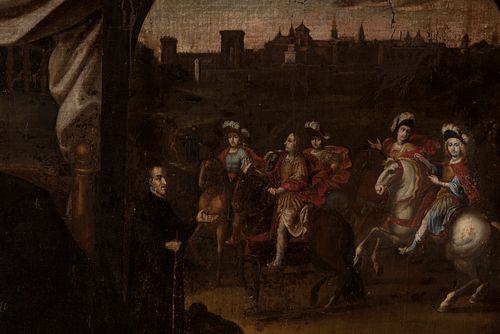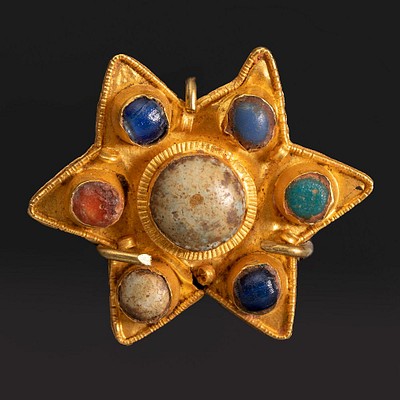Master from Cordoba; second half of the XVII century. "Appearance of the Archangel Saint Raphael to Father Roelas". Oil on canvas.
Lot 64
About Seller
Setdart Auction House
Carrer Aragó 346
Barcelona
Spain
Setdart Subastas was born in 2004 and is currently the first online art auction in Spain with solidity, prestige and reliability guaranteed by our more than 60,000 users. Setdart has a young, dynamic and enterprising team ready to successfully manage the purchase and sale of art works through custom...Read more
Estimate:
EUR€20,000 - EUR€25,000
$21,505.38 - $26,881.72
Absentee vs Live bid
Two ways to bid:
- Leave a max absentee bid and the platform will bid on your behalf up to your maximum bid during the live auction.
- Bid live during the auction and your bids will be submitted real-time to the auctioneer.
Bid Increments
| Price | Bid Increment |
|---|---|
| EUR€0 | EUR€10 |
| EUR€200 | EUR€25 |
| EUR€500 | EUR€50 |
| EUR€1,000 | EUR€100 |
| EUR€3,000 | EUR€200 |
| EUR€5,000 | EUR€500 |
| EUR€10,000 | EUR€1,000 |
| EUR€20,000 | EUR€2,000 |
| EUR€50,000 | EUR€5,000 |
About Auction
By Setdart Auction House
Dec 21, 2021
Set Reminder
2021-12-21 07:30:00
2021-12-21 07:30:00
America/New_York
Bidsquare
Bidsquare : Córdoba: 2,000 Years of Art
https://www.bidsquare.com/auctions/setdart-auction-house/c-rdoba-2-000-years-of-art-8049
Setdart Auction House sofia@setdart.com
Setdart Auction House sofia@setdart.com
- Lot Description
Master from Cordoba; second half of the XVII century. "Appearance of the Archangel Saint Raphael to Father Roelas". Oil on canvas. It has damage to the paint and repainting. Unattached frame. Measurements: 149 x 247 cm; 169 x 254 cm (frame). In this work of landscape format, the author presents us with a dynamic composition, populated with characters, indicating its narrative purpose. In the foreground on the left is the most relevant group, which can be seen not only by their arrangement in the composition, but also by the size of their bodies. This group is formed by Father Roelas, seated in front of an altar where rests an open book (The Bible), and a small censer. He opens his arms in an attitude of welcome. In front of him, the Archangel Saint Raphael, brings his hands to his chest. The neatness of the clothes stands out, which are defined by the white that provides a great luminosity, with respect to the rest of the composition. To this particularity is added the snowy skin, the shine of their golden sandals, as well as the detail of their anatomy. Next to them, we can observe a group of little angels, two of which hold a border with the legend: "I swear to you, by Jesus Christ crucified, that I am Raphael, the angel whom God has placed as guardian of this city". This allows us to identify the theme chosen by the artist. The composition ends with a group arranged in the upper left corner, composed of several characters, richly attired, who are arranged on horses. These are pointed out by Father Roelas, who stands to the left of the group. Andrés Roelas, was a Cordovan priest of the XVI century. His popularity, especially in the city of Cordoba, began when the Archangel Saint Raphael appeared to him four times during the plague epidemic that ravaged the city. The Archangel announced to the father that he would save the city, however, Roelas went to the theologians, who warned him to ask the name of the Archangel in case of a fifth appearance. It was then that Saint Raphael appeared again and said to him: "I swear to you, by Jesus Christ crucified, that I am Raphael, the angel whom God has placed as guardian of this city". After this last presence of the archangel, the plague began to subside and Father Roelas was praised as the one responsible for the miracle. The 17th century marked the arrival of the Baroque in the Andalusian school, with the triumph of naturalism over Mannerist idealism, loose workmanship and many other aesthetic liberties. At this time the school reached its greatest splendor, both for the quality of the works, as well as for the primordial rank of the Sevillian Baroque painting. Thus, during the transition to Baroque we find Juan del Castillo, Antonio Mohedano and Francisco Herrera el Viejo, in whose works the rapid brushstroke and the crude realism of the style is already manifested, and Juan de Roelas, introducer of Venetian colorism. In the middle of the century the period reached its peak, with figures such as Zurbarán, a young Alonso Cano and Velázquez. Finally, in the last third of the century we find Murillo and Valdés Leal, founders in 1660 of an Academy where many of the painters active during the first quarter of the 18th century were trained, such as Meneses Osorio, Sebastián Gómez, Lucas Valdés and others.
- Shipping Info
-
In-house shipping available. Please inquire at admin@setdart.com.
-
- Buyer's Premium



 EUR
EUR CAD
CAD AUD
AUD GBP
GBP MXN
MXN HKD
HKD CNY
CNY MYR
MYR SEK
SEK SGD
SGD CHF
CHF THB
THB

















